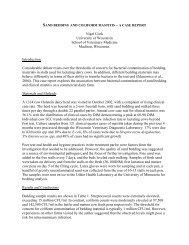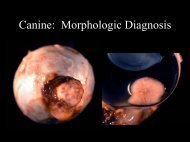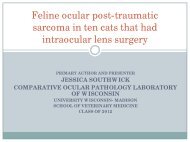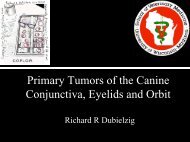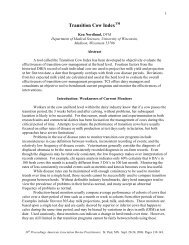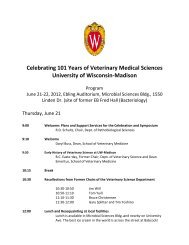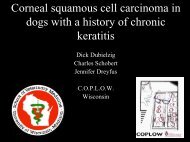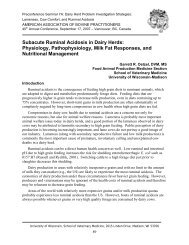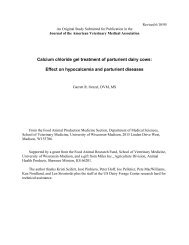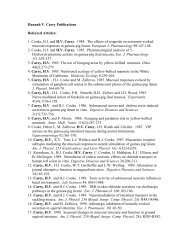On Call Fall / Winter 2011 - School of Veterinary Medicine ...
On Call Fall / Winter 2011 - School of Veterinary Medicine ...
On Call Fall / Winter 2011 - School of Veterinary Medicine ...
You also want an ePaper? Increase the reach of your titles
YUMPU automatically turns print PDFs into web optimized ePapers that Google loves.
Research wishlist<br />
Research laboratories at the <strong>School</strong><br />
<strong>of</strong> <strong>Veterinary</strong> <strong>Medicine</strong> have equipment<br />
needs that would enhance<br />
their ability to find new solutions<br />
to animal (and sometimes human)<br />
health problems.<br />
If you would like to make a difference,<br />
here are some options for you<br />
to consider:<br />
Laser Capture Microdissection<br />
($120,000)<br />
Understanding disease <strong>of</strong>ten<br />
requires knowledge <strong>of</strong> normal and<br />
pathological gene expression. This<br />
state-<strong>of</strong>-the-art system will allow<br />
us to make measurements <strong>of</strong> gene<br />
expression in single cells throughout<br />
the body.<br />
Confocal Laser Microscope<br />
($250,000)<br />
Understanding disease requires<br />
knowledge <strong>of</strong> normal and pathological<br />
function in cells. This microscope<br />
will allow us to visualize normal and<br />
diseased cells throughout the body.<br />
The three-color laser system brings<br />
clarity to images not possible with a<br />
standard microscope.<br />
Oxygen exposure system<br />
($80,000)<br />
Our SVM group studying respiratory<br />
neurobiology is unparalleled in the<br />
world and is making discoveries that<br />
will alter the treatment <strong>of</strong> devastating<br />
disorders <strong>of</strong> the neuromuscular<br />
system.<br />
Breathing Measurement system<br />
($35,000)<br />
Respiratory diseases are a major<br />
cause <strong>of</strong> morbidity and mortality in<br />
both veterinary and human medicine.<br />
To investigate these devastating<br />
diseases, it is necessary to make<br />
accurate measurements <strong>of</strong> breathing<br />
capacity. A “whole body plethysmograph”<br />
allows such measurements in<br />
unstressed and unrestrained animals.<br />
For more information: www.vetmed.<br />
wisc.edu/giving<br />
6<br />
Egg hunt reveals rare condition in parrot<br />
Dr. Christoph<br />
Mans and UW<br />
<strong>Veterinary</strong><br />
Care’s special species<br />
team are no strangers to<br />
the strange. But the case<br />
<strong>of</strong> Meeko, the Timneh<br />
African gray parrot,<br />
was a medical mystery.<br />
In what may have been<br />
the oddest egg-hunt<br />
ever, Mans and his team<br />
palpated, x-rayed, ultrasounded,<br />
and finally<br />
operated in search <strong>of</strong> the<br />
egg they thought Meeko<br />
was carrying. They then<br />
discovered that Meeko<br />
was harboring a fullyformed<br />
ectopic egg.<br />
At 13 years old,<br />
Meeko had never laid an<br />
egg before, but her owners<br />
started to see some<br />
strange signs. “We noticed<br />
that she had picked<br />
her feathers for a brood<br />
patch,” said Tammy<br />
Smith, Meeko’s owner.<br />
“She wasn’t acting like<br />
herself.” They took her<br />
to the local veterinarian<br />
in Plover, who works<br />
with Mans and suggested<br />
they make a visit to UW<br />
<strong>Veterinary</strong> Care to have<br />
their questions answered.<br />
In spite <strong>of</strong> the brood<br />
patch, Meeko was not<br />
trying to lay an egg, and<br />
a physical exam showed<br />
no evidence <strong>of</strong> one. “You<br />
couldn’t feel it at all when<br />
you were palpating,” said Julie<br />
Wenger, the 4 th year veterinary student<br />
assisting with the case. The<br />
team ordered x-rays for a closer<br />
look.<br />
“We took a radiograph and<br />
found a normal looking egg,<br />
which should usually be laid within<br />
24 to 48 hours” said Mans. But<br />
though the egg on that x-ray was<br />
surprising, the real shock came a<br />
week later, when Meeko had still<br />
Meeko is a Timeh Afrian gray parrot who carried an<br />
egg inside her abdominal space.<br />
These radiographs taken a week apart show how the<br />
egg has flipped, which led the veterinarians to believe<br />
the egg was not in the uterus.<br />
not laid the egg. The team ordered<br />
a new round <strong>of</strong> x-rays.<br />
“The egg was actually flipped,”<br />
said Mans. “That’s when we started<br />
to wonder if the egg might not<br />
be in the uterus.” Mans explained<br />
that in its normal position protected<br />
in the uterus, an egg would not<br />
be able to flip end over end.<br />
With no precedent for these<br />
symptoms, Mans theorized that<br />
the egg was ectopic, meaning it<br />
was outside <strong>of</strong> the uterus<br />
and would need to be removed.<br />
<strong>On</strong>ce they were<br />
certain they could not induce<br />
Meeko to lay the egg<br />
herself, Mans scheduled<br />
surgery with Dr. Robert<br />
Hardie at the SVM.<br />
What they found confirmed<br />
his theory; the egg<br />
was simply in the abdominal<br />
space, outside <strong>of</strong> the<br />
uterus. “This has only<br />
been reported sporadically<br />
in textbooks,” said Mans.<br />
“No guidelines for how<br />
to diagnose and manage<br />
ectopic eggs exist.” He explained<br />
that, even stranger,<br />
the perfect shape <strong>of</strong> the<br />
egg suggests it must have<br />
originally formed in the<br />
uterus and probably tore<br />
through the uterine wall.<br />
What would have happened<br />
if they hadn’t taken<br />
x-rays and found the egg?<br />
“No one knows,” said<br />
Mans. Although Meeko<br />
didn’t seem distressed by<br />
the egg as it was, it might<br />
have posed a problem<br />
down the line. “She really<br />
had no clinical signs related<br />
to the ectopic egg,”<br />
said Mans. “She was eating,<br />
singing, and dancing.<br />
The egg may have been<br />
there for longer than we<br />
think.” But Meeko had no<br />
ability to lay the egg herself,<br />
and several potential<br />
issues, like trauma that<br />
might cause the egg to break, motivated<br />
Dr. Mans to operate. “We<br />
had to take it out as a precaution,”<br />
he said.<br />
After surgery, Meeko recovered<br />
well, and her owners are glad to<br />
have their medical mystery solved.<br />
“We were very happy that we<br />
decided to bring her here,” said<br />
Smith. “We got a lot <strong>of</strong> answers,<br />
and we learned a lot, too.”<br />
Ali Bartol



